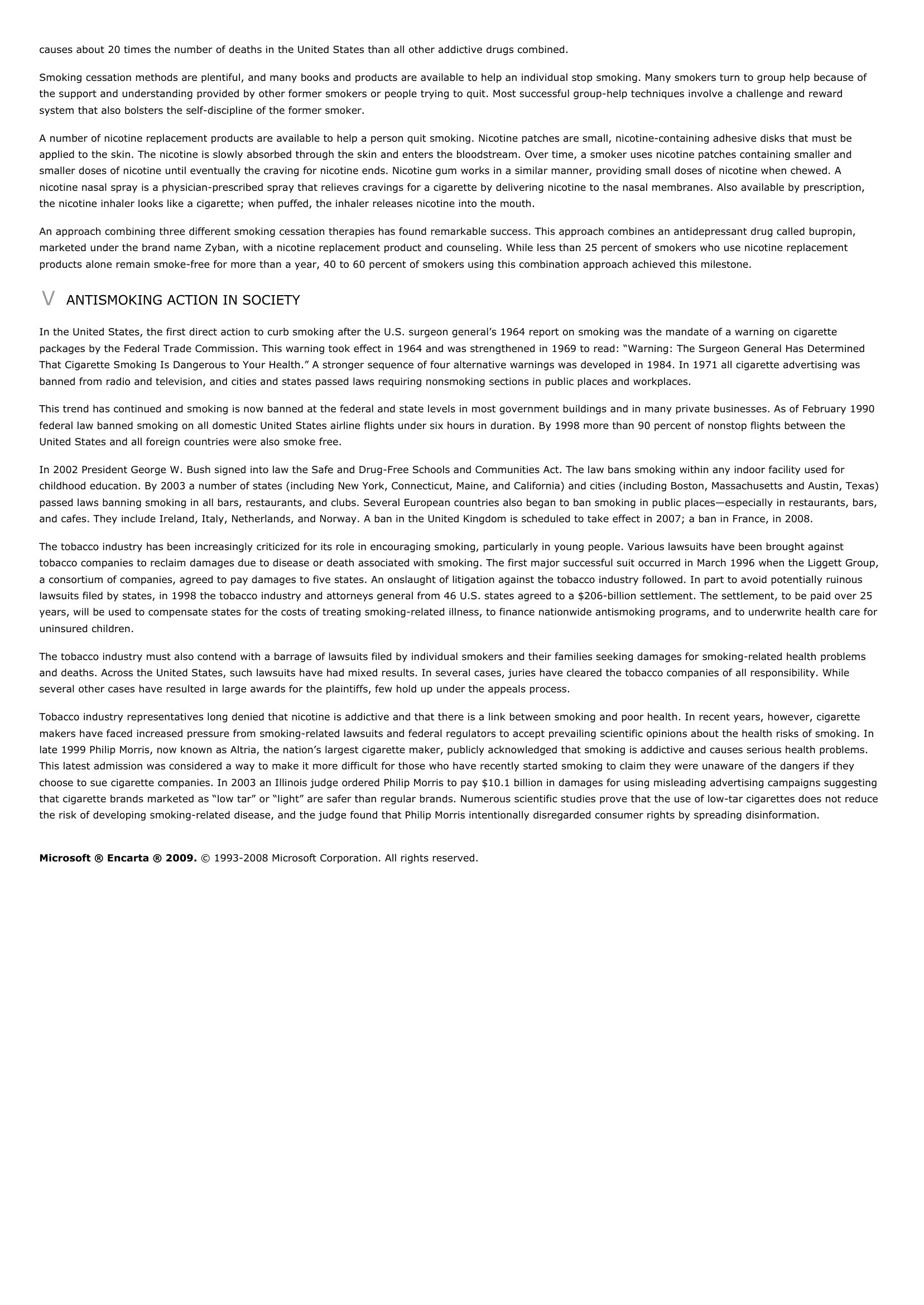Smoking.
Publié le 11/05/2013

Extrait du document
«
causes about 20 times the number of deaths in the United States than all other addictive drugs combined.
Smoking cessation methods are plentiful, and many books and products are available to help an individual stop smoking.
Many smokers turn to group help because ofthe support and understanding provided by other former smokers or people trying to quit.
Most successful group-help techniques involve a challenge and rewardsystem that also bolsters the self-discipline of the former smoker.
A number of nicotine replacement products are available to help a person quit smoking.
Nicotine patches are small, nicotine-containing adhesive disks that must beapplied to the skin.
The nicotine is slowly absorbed through the skin and enters the bloodstream.
Over time, a smoker uses nicotine patches containing smaller andsmaller doses of nicotine until eventually the craving for nicotine ends.
Nicotine gum works in a similar manner, providing small doses of nicotine when chewed.
Anicotine nasal spray is a physician-prescribed spray that relieves cravings for a cigarette by delivering nicotine to the nasal membranes.
Also available by prescription,the nicotine inhaler looks like a cigarette; when puffed, the inhaler releases nicotine into the mouth.
An approach combining three different smoking cessation therapies has found remarkable success.
This approach combines an antidepressant drug called bupropin,marketed under the brand name Zyban, with a nicotine replacement product and counseling.
While less than 25 percent of smokers who use nicotine replacementproducts alone remain smoke-free for more than a year, 40 to 60 percent of smokers using this combination approach achieved this milestone.
V ANTISMOKING ACTION IN SOCIETY
In the United States, the first direct action to curb smoking after the U.S.
surgeon general’s 1964 report on smoking was the mandate of a warning on cigarettepackages by the Federal Trade Commission.
This warning took effect in 1964 and was strengthened in 1969 to read: “Warning: The Surgeon General Has DeterminedThat Cigarette Smoking Is Dangerous to Your Health.” A stronger sequence of four alternative warnings was developed in 1984.
In 1971 all cigarette advertising wasbanned from radio and television, and cities and states passed laws requiring nonsmoking sections in public places and workplaces.
This trend has continued and smoking is now banned at the federal and state levels in most government buildings and in many private businesses.
As of February 1990federal law banned smoking on all domestic United States airline flights under six hours in duration.
By 1998 more than 90 percent of nonstop flights between theUnited States and all foreign countries were also smoke free.
In 2002 President George W.
Bush signed into law the Safe and Drug-Free Schools and Communities Act.
The law bans smoking within any indoor facility used forchildhood education.
By 2003 a number of states (including New York, Connecticut, Maine, and California) and cities (including Boston, Massachusetts and Austin, Texas)passed laws banning smoking in all bars, restaurants, and clubs.
Several European countries also began to ban smoking in public places—especially in restaurants, bars,and cafes.
They include Ireland, Italy, Netherlands, and Norway.
A ban in the United Kingdom is scheduled to take effect in 2007; a ban in France, in 2008.
The tobacco industry has been increasingly criticized for its role in encouraging smoking, particularly in young people.
Various lawsuits have been brought againsttobacco companies to reclaim damages due to disease or death associated with smoking.
The first major successful suit occurred in March 1996 when the Liggett Group,a consortium of companies, agreed to pay damages to five states.
An onslaught of litigation against the tobacco industry followed.
In part to avoid potentially ruinouslawsuits filed by states, in 1998 the tobacco industry and attorneys general from 46 U.S.
states agreed to a $206-billion settlement.
The settlement, to be paid over 25years, will be used to compensate states for the costs of treating smoking-related illness, to finance nationwide antismoking programs, and to underwrite health care foruninsured children.
The tobacco industry must also contend with a barrage of lawsuits filed by individual smokers and their families seeking damages for smoking-related health problemsand deaths.
Across the United States, such lawsuits have had mixed results.
In several cases, juries have cleared the tobacco companies of all responsibility.
Whileseveral other cases have resulted in large awards for the plaintiffs, few hold up under the appeals process.
Tobacco industry representatives long denied that nicotine is addictive and that there is a link between smoking and poor health.
In recent years, however, cigarettemakers have faced increased pressure from smoking-related lawsuits and federal regulators to accept prevailing scientific opinions about the health risks of smoking.
Inlate 1999 Philip Morris, now known as Altria, the nation’s largest cigarette maker, publicly acknowledged that smoking is addictive and causes serious health problems.This latest admission was considered a way to make it more difficult for those who have recently started smoking to claim they were unaware of the dangers if theychoose to sue cigarette companies.
In 2003 an Illinois judge ordered Philip Morris to pay $10.1 billion in damages for using misleading advertising campaigns suggestingthat cigarette brands marketed as “low tar” or “light” are safer than regular brands.
Numerous scientific studies prove that the use of low-tar cigarettes does not reducethe risk of developing smoking-related disease, and the judge found that Philip Morris intentionally disregarded consumer rights by spreading disinformation.
Microsoft ® Encarta ® 2009. © 1993-2008 Microsoft Corporation.
All rights reserved..
»
↓↓↓ APERÇU DU DOCUMENT ↓↓↓
Liens utiles
- XXXII Entré chez elle après avoir boutonné son smoking neuf, il la trouva devant la psyché, merveilleuse dans une robe du soir.
- CHEVALIER, Maurice (1888-1972) Chanteur gouailleur, portant smoking et canotier, le " gars de Ménilmontant " impose durant cinquante ans " sa pomme " sur les scènes du music-hall du monde entier.
- CHEVALIER, Maurice (1888-1972) Chanteur gouailleur, portant smoking et canotier, le " gars de Ménilmontant " impose durant cinquante ans " sa pomme " sur les scènes du music-hall du monde entier.
- Impossibilité de prêter un smoking
- Demande de prêt de smoking

































